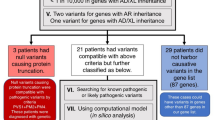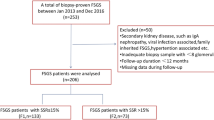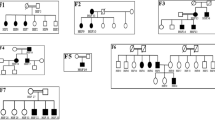Abstract
Steroid-resistant nephrotic syndrome (SRNS) represents glomerular disease resulting from a number of different etiologies leading to focal segmental glomerulosclerosis (FSGS). Recently, many genes causing SRNS/FSGS have been identified. These genes encode the proteins associated with the formation and/or maintenance of glomerular filtration barrier. Next-generation sequencing is used to analyze large numbers of genes at lower costs. To identify the genetic background of Japanese patients, we studied 26 disease-causing genes using whole-exome sequencing analysis in 24 patients with SRNS and/or FSGS from 22 different Japanese families. We finally found eight causative gene mutations, four recessive and four dominant gene mutations, including three novel mutations, in six patients from five different families, and one novel predisposing mutation in two patients from two different families. Causative gene mutations have only been identified in ~20% of families and further analysis is necessary to identify the unknown disease-causing gene. Identification of the disease-causing gene would support clinical practices, including the diagnosis, understanding of pathogenesis and treatment.
Similar content being viewed by others
Log in or create a free account to read this content
Gain free access to this article, as well as selected content from this journal and more on nature.com
or
References
Schlesinger, E. R., Sultz, H. A., Mosher, W. E. & Feldman, J. G. The nephrotic syndrome. Its incidence and implications for the community. Am. J. Dis. Child. 116, 623–632 (1968).
Niaudet, P., Boyer, O. in Pediatric Nephrology 6th edn (eds Avner, E., Harmon, W., Niaudet, P. & Yoshikawa, N.) 667–702 (Springer: New York, NY, USA, 2009).
International Study on Kidney Disease in Children The primary nephrotic syndrome in children. Identification of patients with minimal change nephrotic syndrome from initial response to prednisone. A report of the International Study of Kidney Disease in Children. J. Pediatr. 98, 561–564 (1981).
Banaszak, B. & Banaszak, P. The increasing incidence of initial steroid resistance in childhood nephrotic syndrome. Pediatr. Nephrol. 27, 927–932 (2012).
Kriz, W. The pathogenesis of ‘classic’ focal segmental glomerulosclerosis-lessons from rat models. Nephrol. Dial. Transplant 18, vi39–vi44 (2003).
Wharram, B. L., Goyal, M., Wiggins, J. E., Sanden, S. K., Hussain, S., Filipiak, W. E. et al. Podocyte depletion causes glomerulosclerosis: diphtheria toxin-induced podocyte depletion in rats expressing human diphtheria toxin receptor transgene. J. Am. Soc. Nephrol. 16, 2941–2952 (2005).
Sato, Y., Wharram, B. L., Lee, S. K., Wickman, L., Goyal, M., Venkatareddy, M. et al. Urine podocyte mRNAs mark progression of renal disease. J. Am. Soc. Nephrol. 20, 1041–1052 (2009).
Patrakka, J. & Tryggvason, K. New insights into the role of podocytes in proteinuria. Nat. Rev. Nephrol. 5, 463–468 (2009).
Gbadegesin, R., Lavin, P., Foreman, J. & Winn, M. Pathogenesis and therapy of focal segmental glomerulosclerosis: an update. Pediatr. Nephrol. 26, 1001–1015 (2011).
Sadowski, C. E., Lovric, S., Ashraf, S., Pabst, W. L., Gee, H. Y., Kohl, S. et al. A single-gene cause in 29.5% of cases of steroid-resistant nephrotic syndrome. J. Am. Soc. Nephrol. 26, 1279–1289 (2015); pii: ASN.2014050489.
Rood, I. M., Deegens, J. K. & Wetzels, J. F. Genetic causes of focal segmental glomerulosclerosis: implications for clinical practice. Nephrol. Dial. Transplant. 27, 882–890 (2012).
Brown, E. J., Pollak, M. R. & Barua, M. Genetic testing for nephrotic syndrome and FSGS in the era of next-generation sequencing. Kidney Int. 85, 1030–1038 (2014).
van Husen, M. & Kemper, M. J. New therapies in steroid-sensitive and steroid-resistant idiopathic nephrotic syndrome. Pediatr. Nephrol. 26, 881–892 (2011).
Tarshish, P., Tobin, J. N., Bernstein, J. & Edelmann, C. M. Jr. Prognostic significance of the early course of minimal change nephrotic syndrome: report of the International Study of Kidney Disease in Children. J. Am. Soc. Nephrol. 8, 769–776 (1997).
Saleem, M. A. New developments in steroid-resistant nephrotic syndrome. Pediatr. Nephrol. 28, 699–709 (2013).
Li, H. & Durbin, R. Fast and accurate short read alignment with Burrows–Wheeler transform. Bioinformatics 25, 754–760 (2009).
McKenna, A., Hanna, M., Banks, E., Sivachenko, A., Cibulskis, K., Kernytsky, A. et al. The Genome Analysis Toolkit: a MapReduce framework for analyzing next-generation DNA sequencing data. Genome Res. 20, 1297–1303 (2010).
Wang, K., Li, M. & Hakonarson, H. ANNOVAR: functional annotation of genetic variants from high-throughput sequencing data. Nucleic. Acids Res. 38, e164 (2010).
Adzhubei, I. A., Schmidt, S., Peshkin, L., Ramensky, V. E., Gerasimova, A., Bork, P. et al. A method and server for predicting damaging missense mutations. Nat. Methods 7, 248–249 (2010).
Grantham, R. Amino acid difference formula to help explain protein evolution. Science 185, 862–864 (1974).
Siepel, A., Bejerano, G., Pedersen, J. S., Hinrichs, A. S., Hou, M., Rosenbloom, K. et al. Evolutionarily conserved elements in vertebrate, insect, worm, and yeast genomes. Genome Res. 15, 1034–1050 (2005).
Cooper, G. M., Stone, E. A., Asimenos, G. ; NISC Comparative Sequencing Program, Green, E. D., Batzoglou, S. & Sidow, A. Distribution and intensity of constraint in mammalian genomic sequence. Genome Res. 15, 901–913 (2005).
Weber, S., Gribouval, O., Esquivel, E. L., Morinière, V., Tête, M. J., Legendre, C. et al. NPHS2 mutation analysis shows genetic heterogeneity of steroid-resistant nephrotic syndrome and low post-transplant recurrence. Kidney Int. 66, 571–579 (2004).
Bredrup, C., Matejas, V., Barrow, M., Bláhová, K., Bockenhauer, D., Fowler, D. J. et al. Ophthalmological aspects of Pierson syndrome. Am. J. Ophthalmol. 146, 602–611 (2008).
Roselli, S., Moutkine, I., Gribouvalm, O., Benmerah, A. & Antignac, C. Plasma membrane targeting of podocin through the classical exocytic pathway: effect of NPHS2 mutations. Traffic 5, 37–44 (2004).
Huber, T. B., Simons, M., Hartleben, B., Sernetz, L., Schmidts, M., Gundlach, E. et al. Molecular basis of the functional podocin–nephrin complex: mutations in the NPHS2 gene disrupt nephrin targeting to lipid raft microdomains. Hum. Mol. Genet. 12, 3397–3405 (2003).
Brown, E. J., Schlöndorff, J. S, Becker, D. J, Tsukaguchi, H., Tonna, S. J., Uscinski, A. L. et al. Mutations in the formin gene INF2 cause focal segmental glomerulosclerosis. Nat. Genet. 42, 72–76 (2010).
Ruf, R. G., Lichtenberger, A., Karle, S. M., Haas, J. P., Anacleto, F. E., Schultheiss, M. et al. Patients with mutations in NPHS2 (podocin) do not respond to standard steroid treatment of nephrotic syndrome. J. Am. Soc. Nephrol. 15, 722–732 (2004).
Matejas, V., Hinkes, B., Alkandari, F., Al-Gazali, L., Annexstad, E., Aytac, M. B. et al. Mutations in the human laminin beta 2 (LAMB2) gene and the associated phenotypic spectrum. Hum. Mutat. 31, 992–1002 (2010).
Kim, J. M., Wu, H., Green, G., Winkler, C. A., Kopp, J. B., Miner, J. H. et al. CD2-associated protein haploinsufficiency is linked to glomerular disease susceptibility. Science 300, 1298–1300 (2003).
Schwarz, K., Simons, M., Reiser, J., Saleem, M. A., Faul, C., Kriz, W. et al. Podocin, a raft-associated component of the glomerular slit diaphragm, interacts with CD2AP and nephrin. J. Clin. Invest. 108, 1621–1629 (2001).
Wolf, G. & Stahl, R. A. CD2-associated protein and glomerular disease. Lancet 362, 1746–1748 (2003).
Löwik, M. M., Groenen, P. J., Pronk, I., Lilien, M. R., Goldschmeding, R., Dijkman, H. B. et al. Focal segmental glomerulosclerosis in a patient homozygous for a CD2AP mutation. Kidney Int. 72, 1198–1203 (2007).
Gigante, M., Pontrelli, P., Montemurno, E., Roca, L., Aucella, F., Penza, R. et al. CD2AP mutations are associated with sporadic nephrotic syndrome and focal segmental glomerulosclerosis (FSGS). Nephrol. Dial. Transplant. 24, 1858–1864 (2009).
Winn, M. P. 2007 Young Investigator Award: TRP’ing into a new era for glomerular disease. J. Am. Soc. Nephrol. 19, 1071–1075 (2008).
Orloff, M. S., Iyengar, S. K., Winkler, C. A., Goddard, K. A., Dart, R. A., Ahuja, T. S. et al. Variants in the Wilms' tumor gene are associated with focal segmental glomerulosclerosis in the African American population. Physiol. Genom. 21, 212–221 (2005).
Gebeshuber, C. A., Kornauth, C., Dong, L., Sierig, R., Seibler, J., Reiss, M. et al. Focal segmental glomerulosclerosis is induced by microRNA-193a and its downregulation of WT1. Nat. Med. 19, 481–487 (2013).
Niaudet, P. & Gubler, M. C. WT1 and glomerular diseases. Pediatr. Nephrol. 21, 1653–1660 (2006).
Boyer, O., Nevo, F., Plaisier, E., Funalot, B., Gribouval, O., Benoit, G. et al. INF2 mutations in Charcot–Marie–Tooth disease with glomerulopathy. N. Engl. J. Med. 365, 2377–2388 (2011).
Toyota, K., Ogino, D., Hayashi, M., Taki, M., Saito, K., Abe, A. et al. INF2 mutations in Charcot–Marie–Tooth disease complicated with focal segmental glomerulosclerosis. J. Peripher. Nerv. Syst. 18, 97–98 (2013).
Heeringa, S. F., Chernin, G., Chaki, M., Zhou, W., Sloan, A. J., Ji, Z. et al. COQ6 mutations in human patients produce nephritic syndrome with sensorineural deafness. J. Clin. Invest. 121, 2013–2024 (2011).
Montini, G., Malaventura, C. & Salviati, L. Early coenzyme Q10 supplementation in primary coenzyme Q10 deficiency. N. Engl. J. Med. 358, 2849–2850 (2008).
Acknowledgements
This research was supported in part by a Grant-in-Aid for Scientific Research (C) from the Ministry of Education, Science, Culture and Sports of Japan. We thank all patients and families who participated in this study.
Author information
Authors and Affiliations
Corresponding author
Ethics declarations
Competing interests
The authors declare no conflict of interest.
Additional information
Supplementary Information accompanies the paper on Journal of Human Genetics website
Supplementary information
Rights and permissions
About this article
Cite this article
Ogino, D., Hashimoto, T., Hattori, M. et al. Analysis of the genes responsible for steroid-resistant nephrotic syndrome and/or focal segmental glomerulosclerosis in Japanese patients by whole-exome sequencing analysis. J Hum Genet 61, 137–141 (2016). https://doi.org/10.1038/jhg.2015.122
Received:
Revised:
Accepted:
Published:
Issue date:
DOI: https://doi.org/10.1038/jhg.2015.122
This article is cited by
-
Precise clinicopathologic findings for application of genetic testing in pediatric kidney transplant recipients with focal segmental glomerulosclerosis/steroid-resistant nephrotic syndrome
Pediatric Nephrology (2023)
-
An inactivating human TRPC6 channel mutation without focal segmental glomerulosclerosis
Cellular and Molecular Life Sciences (2023)
-
Mutational landscape of TRPC6, WT1, LMX1B, APOL1, PTPRO, PMM2, LAMB2 and WT1 genes associated with Steroid resistant nephrotic syndrome
Molecular Biology Reports (2021)
-
The formin INF2 in disease: progress from 10 years of research
Cellular and Molecular Life Sciences (2020)
-
Pair analysis and custom array CGH can detect a small copy number variation in COQ6 gene
Clinical and Experimental Nephrology (2019)



